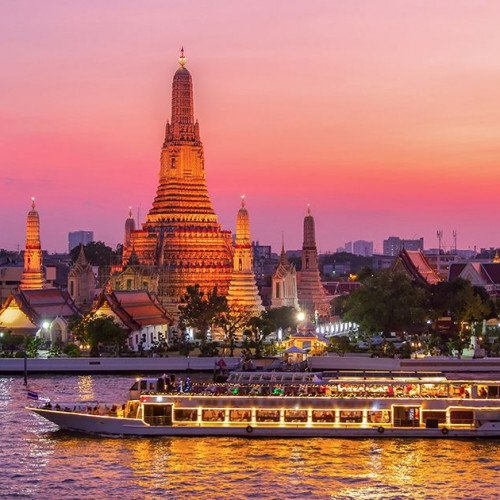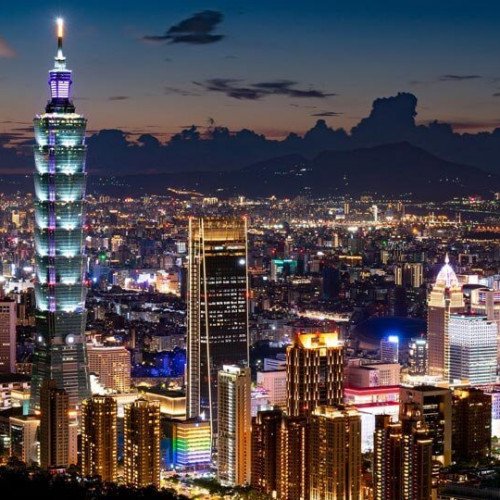Most vibrant country to visit in Asia: Taiwan vs Thailand

Thailand
Thailand, officially the Kingdom of Thailand and formerly known as Siam, is a country in Southeast Asia. Located at the centre of the Indochinese Peninsula, it is composed of 76 provinces spanning 513,120 square kilometres (198,120 sq mi), with a population of over 66 million people; Thailand is the world's 50th-largest country by land area and the 22nd-most-populous. The capital and largest city is Bangkok, a special administrative area. Thailand is bordered to the north by Myanmar and Laos, to the east by Laos and Cambodia, to the south by the Gulf of Thailand and Malaysia, and to the west by the Andaman Sea and the southern extremity of Myanmar. Its maritime boundaries include Vietnam in the Gulf of Thailand to the southeast, and Indonesia and India on the Andaman Sea to the southwest. Nominally, Thailand is a constitutional monarchy and parliamentary democracy; however, in recent history, its government has experienced multiple coups and periods of military dictatorships. Tai peoples migrated from southwestern China to mainland Southeast Asia from the 11th century; the oldest known mention of their presence in the region by the exonym Siamese dates to the 12th century. Various Indianised kingdoms such as the Mon kingdoms, Khmer Empire and Malay states ruled the region, competing with Thai states such as the Kingdoms of Ngoenyang, Sukhothai, Lan Na and Ayutthaya, which rivalled each other. Documented European contact began in 1511 with a Portuguese diplomatic mission to Ayutthaya, which became a regional power by the end of the 15th century. Ayutthaya reached its peak during cosmopolitan Narai's reign (1656–1688), gradually declining thereafter until being ultimately destroyed in the 1767 Burmese–Siamese War. Taksin (r. 1767–1782) quickly reunified the fragmented territory and established the short-lived Thonburi Kingdom. He was succeeded in 1782 by Buddha Yodfa Chulaloke (r. 1782–1809), the first monarch of the current Chakri dynasty. Throughout the era of Western imperialism in Asia, Siam remained the only nation in the region to avoid being colonized by foreign powers, although the Siamese government was often forced to cede both territory and trade concessions in unequal treaties. The Siamese system of government was centralized and transformed into modern unitary absolute monarchy in the reign of Chulalongkorn (r. 1868–1910). Siam joined World War I siding with the allies, a political decision to amend the unequal treaties. Following a bloodless revolution in 1932, Siam became a constitutional monarchy and changed its official name to "Thailand". Thailand was a satellite of Japan in World War II. In the late 1950s, a military coup under Field Marshal Sarit Thanarat revived the monarchy's historically influential role in politics. Thailand became a major ally of the United States, and played a key anti-communist role in the region as a member of the Southeast Asia Treaty Organization (SEATO). Apart from a brief period of parliamentary democracy in the mid-1970s, Thailand has periodically alternated between democracy and military rule. Since the 2000s, Thailand has been caught in a bitter political conflict between supporters and opponents of Thaksin Shinawatra, which culminated in two coups, most recently in 2014 and the establishment of its current and 20th constitution and faces the ongoing 2020 Thai protests. Thailand is a founding member of the Association of Southeast Asian Nations (ASEAN). Despite comparatively sporadic changes in leadership, it is considered a middle power in global affairs. With a high level of human development, the second-largest economy in Southeast Asia, and the 20th-largest in the world by PPP, Thailand is classified as a newly industrialized economy; manufacturing, agriculture, and tourism are leading sectors of the economy.
Statistics for this Xoptio

Taiwan
Taiwan (traditional Chinese: 臺灣/台灣; simplified Chinese: 台湾; pinyin: Táiwān), officially the Republic of China (ROC), is a country in East Asia. Neighbouring countries include the People's Republic of China (PRC) to the northwest, Japan to the northeast, and the Philippines to the south. The main island of Taiwan has an area of 35,808 square kilometres (13,826 sq mi), with mountain ranges dominating the eastern two-thirds and plains in the western third, where its highly urbanised population is concentrated. Taipei is the capital as well as the largest metropolitan area of Taiwan. Other major cities include New Taipei, Kaohsiung, Taichung, Tainan and Taoyuan. With 23.57 million inhabitants, Taiwan is among the most densely populated countries. Austronesian-speaking ancestors of Taiwanese indigenous peoples settled the island around 6,000 years ago. In the 17th century, partial Dutch colonization opened the island to large-scale Han Chinese immigration. After the brief rule of part of western Taiwan by the Kingdom of Tungning, the island was annexed in 1683 by the Qing dynasty of China, and ceded to the Empire of Japan in 1895. The Republic of China, which had overthrown and succeeded the Qing in 1911, took control of Taiwan on behalf of the World War II Allies following the surrender of Japan in 1945. The resumption of the Chinese Civil War resulted in the ROC's loss of mainland China to forces of the Chinese Communist Party and retreat to Taiwan in 1949. Its effective jurisdiction has since been limited to Taiwan and numerous smaller islands. In the early 1960s, Taiwan entered a period of rapid economic growth and industrialisation called the "Taiwan Miracle". In the late 1980s and early 1990s, the ROC transitioned from a one-party military dictatorship to a multi-party democracy with a semi-presidential system. Taiwan's export-oriented industrial economy is the 21st-largest in the world by nominal GDP, and 20th-largest by PPP measures, with major contributions from steel, machinery, electronics and chemicals manufacturing. Taiwan is a developed country, ranking 15th in GDP per capita. It is ranked highly in terms of political and civil liberties, education, health care and human development.The political status of Taiwan is contentious. The ROC government held China's seat in the UN until it was replaced by the PRC in 1971. It continued to claim to be the legitimate representative of China, though this claim has been downplayed since democratization in the 1990s. Taiwan is claimed by the PRC, which refuses diplomatic relations with countries that recognise the ROC. Taiwan maintains official diplomatic relations with 14 out of 193 UN member states and the Holy See, though many countries maintain unofficial diplomatic ties with Taiwan through representative offices and institutions that function as de facto embassies and consulates. International organisations in which the PRC participates either refuse to grant membership to Taiwan or allow it to participate only on a non-state basis under various names. Domestically, the major political contention is between parties favouring eventual Chinese unification and promoting a Chinese identity contrasted with those aspiring to independence and promoting Taiwanese identity, although both sides have moderated their positions to broaden their appeal.